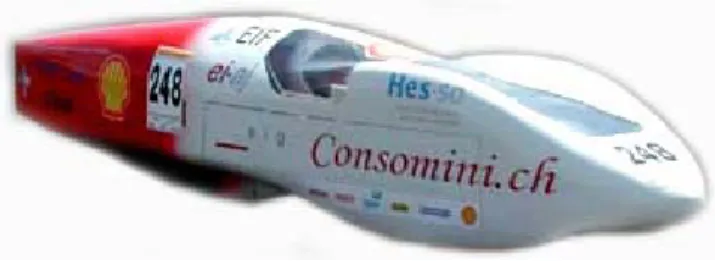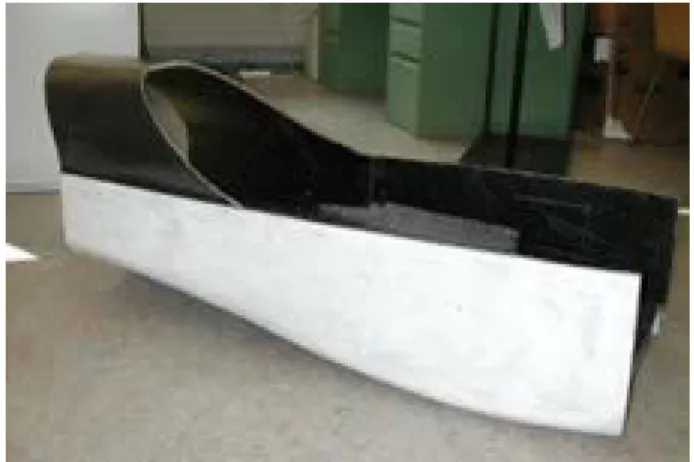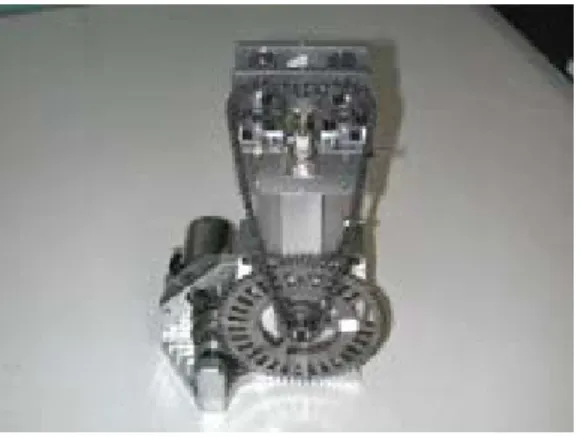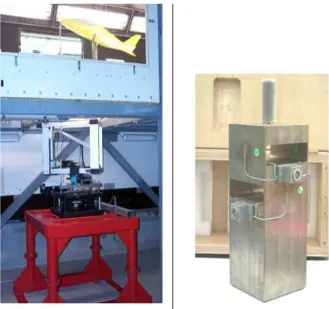Wind tunnel testing of low consumption vehicle consomini
Texte intégral
(2) Wind tunnel testing of low consumption vehicle « Consomini » Michel Perraudin, professor, Florian Lanier, assistant; CMEFE, Ecole d’Ingénieurs de Genève, CH-1202 Geneva, Switzerland. Abstract. This paper presents the study of a very low consumption vehicle. This vehicle took part, among 218 other competitors from all around the world, to the Shell Eco-Marathon race held in June 2004 in Nogaro (France). At this occasion, it travels 1200 km with only one liter of fuel. Our team wins the design and the technology awards. The design of the body, optimized to reduce the aerodynamic drag, has been developped by the CMEFE (group of Competences in Fluid MEchanics and Energetics) of Ecole d'Ingénieurs de Genève. We present also some other activities of this institute. Keywords: Consomini, vehicle, wind tunnel, aerodynamics, automotive engineering, energy consumption.. Low consumption vehicles : a challenge for the new century Twenty years ago Shell company launched a great challenge to all engineers : To develop and produce very low consumption vehicles able to run hundreds of kilometers with only one liter of traditional fossil fuel. This challenge appears immediately very motivating. From 680 km per liter in 1985 at 25 kph average speed, the record has been established in 2004 with 3'410 km per liter at 30 kph average speed. During the race, the consumption is calculated by extrapolating the consumption realized over seven rounds of the circuit, this represents a course of approximately 25 kilometers.. The LMTH of Ecole d’Ingénieurs de l'Arc jurassien built the propulsion (four stroke engine), the laboratory for carried systems developed the electronics. The department for mechanical engineering of Ecole d'Ingénieurs de Fribourg designed the frame. Finally, the CMEFE (group of Competences in Fluid MEchanics and Energetics) of Ecole d'Ingénieurs de Genève design the body, and carried out aerodynamic investigations in wind tunnel. This project constitutes the first step of a main project related to the development of an urban vehicle with low fuel consumption using bio-fuel. The team includes twenty professors, assistants and students. They work on several engineering fields such aerodynamics, thermal systems, materials, mechanical systems, etc. They built a very efficient vehicle using high technologies. Carbon and Kevlar fibers, high resistance steels, etc. The total weight of the vehicle is 30 Kg.. Fig. 1 : Consomini : A very high efficiency vehicle able to cover 1230 km with only one liter of traditional fossile fuel.. Energy efficiency is our main focus After months of efforts, the vehicle with low fuel consumption - Consomini – made a run of 1'234 km with one liter of fuel at an average speed of 30 kph at the 20th Shell Eco-Marathon, which took place May 15th and 16th, 2004 on the French circuit of Nogaro. The prototype held the attention of the jury. The team wins the design and the technical awards. Three institutes of the University of Applied Sciences of West Switzerland (HES-SO) shared their knowledge and their competences in order to build a car, baptized "Consomini". This took the departure of 19th and 20th edition of the Eco-marathon.. Fig. 2 : The Consomini team.
(3) Engineering. Aerodynamics. This year Consomini wins two awards : Design and The aerodynamics was developed by the CMEFE of Ecole Technology. The solutions developed by the team are very d'Ingénieurs de Genève. Design and aerodynamics were studied using an experimental approach. Models were built innovating. to perform wind tunnel tests. The regions where a separation of the flow can occur were investigated using visualization methods and pressure measurements. The forces and moments, essentially the drag and the lift, were measured using six components balances developed at the CMEFE. During a first step a 1/8 scale model is built based upon expertise and specifications. Then, preliminary tests are done in a small wind tunnel. This approach reduces significantly the costs.. __. Fig. 3 : Body and frame are only one. The geometry is then scanned using a 3D scanner. The data file is processed using state of the art surface software to produce a CAD file. The geometry is smoothed using surface splines. The numerical data are translated into a NC command file for machining. A four axis machine is used to produced a full scale model.. The body in carbon-Kevlar developed using scaled tests in wind tunnel, the directional wheel at the rear (solution never chosen before), the ergonomics and the electronic interface lead to a second rank at the design competition.. Fig. 4 : 3D scanning of the 1/8 scale model. Fig. 7 : Interior's volumes and general shape. The propulsion system developed by our team includes a sophisticated electronics and a real time communication system to manage all parameters by the team during the race. This lead to a third rank at the technology competition.. Fig. 5 : Data file after scanning.
(4) Wind tunnel investigations The wind tunnel tests have shown very high performances trough the full speed range. The coefficients of drag, lift and lateral force are calculated. They are presented in Fig. 10. Fig. 6 : Final data file ready for the production of the full scale prototype. The full scale model is produced in two parts. They are assembled, polished and instrumented. The structure to install the model on the balance is also added to the model. At the end of the tests, the full scale model is scanned another time to get an archive data file of the final version of the model. The model used for the tests is also the master of the molds used to produce the vehicle. Fig. 9 : Investigations in the wind tunnel test section of CMEFE. 0.30 0.25 0.20. Cx. 0.15. Cy. 0.10. Cz. 0.05 0.00 -0.05. Fig. 8 : Machining of the full scale prototype. 0. 5. 10. 15. 20. 25 speed [m/s]. Fig. 10 : Drag coefficient Cx, lift coefficient Cz and lateral force coefficient Cy.
(5) The CMEFE of Ecole d'Ingénieurs de Genève The four stroke engine has been developed by the team at The CMEFE is an institute acting in the field of fluid the LMTH. The fuel used a traditional 95 Ron fossil fuel dynamics and energetics. It exists since 1920. available at every station. The mechanical power developed by the engine is 1 hp at 3'000 rpm. The partners of CMEFE are vehicle manufacturers, sport equipement producers, sport teams, energy industries, etc. High quality human and material ressources are available at CMEFE in the field of fluid dynamics, thermal systems engineering and energy conversion. The engine. Equipments CMEFE equipments includes several wind tunnels from low speed to supersonic flows. It includes the instrumentations, visualization systems, laser Doppler velocimetry, etc. The main wind tunnel of the CMEFE is equipped with four blowers of 100 hp each for a total of 400 kW. The maximal air velocity is 300 kph in a test section of 6.6 ft x 4.9 ft. A second test section is also available for experiments with dimensions of 11.2 ft x 11.2 ft.. __ Fig. 11 : The four stroke engine. The electronics A computer manages all data coming from several sensors and from the telemetry. It controls the engine, the propulsion system and gives to the team information regarding consumption, average speed, etc.. The propulsion The energy is given to the rear wheel by the use of a chain. The clutch is designed to engage without any slipping who would results in loss of energy.. Fig. 13 : CMEFE main wind tunnel, 300 kph, 6.6 ft x 4.9 ft The calibration wind tunnel has a small and very low turbulence test section and is used to calibrate instrumentations as hot wire anemometers. The Eiffel wind tunnel has a test section of 1.3 ft x 1.0 ft where flows until 300 kph can be achieved. It uses a 30 hp electrical motor.. Fig. 12 : Propulsion system with clutch. The supersonic wind tunnel is used to study airflows until Mach numbers of 2.4 (about 2'900 kph). The dimensions of the test section are 0.4 ft x 0.3 ft..
(6) CFD software The CMEFE develops numerical algorithms to compute flows around bodies or to investigate many questions. It uses also commercially available codes for thermal and fluid dynamic studies.. Fig. 14 : Supersonic wind tunnel (Mach 2.4). Fig. 16 : Examples of balances used to measure forces and moments until 6 components (3 forces and 3 moments simultaneously) 3D scanner. Fig. 15 : Visualization of shock waves using a Schlieren system. As described in this paper, the CMEFE used a 3D scanner to record experimental changes done on models and to supply to the customer high quality data files (Laboratory of metrology).. CMEFE expects from its participation to the World Engineer's Convention the possibilities to meet students, professors and industrial companies from other countries. This is a unique opportunity to start partnerships and discover all faces of engineering around the world. Other activities. Fig. 17 : World champions of high speed skiing are working with CMEFE. Conclusions The University of Applied Sciences of West Switzerland (HES-SO) developed and produced a very high efficiency vehicle. The CMEFE was in charge of the aerodynamics. Olympic games held in Salt Lake City went at the. For many years the CMEFE worked on the aerodynamics of buildings and constructions (evaluation of loads due to the wind), other activities are also undertaken in the field of aerodynamics and energy. Professor Michel PERRAUDIN, in charge of this laboratory, develops also many systems related to measurements, calibration and testing. Today, our institute is acting in several projects of inlets for high speed trains, thermal analyses for energy production, energy concepts for cities, methods for measuring friction coefficients, sensors, etc. The CMEFE has also a world reputation for its contribution to the sports. Luge team from France for the References :.
(7) CMEFE to improve its performances. Sky surfers, flying men, high speed skiing use the CMEFE resources to develop their revolutionary systems.. References : http://www.eig.unige.ch/cmefe http://www.consomini.ch. Contact Head of CMEFE. Consomini project manager. Prof. Michel Perraudin. Prof. Thierry Robert-Nicoud. e-mail : perraudin@eig.unige.ch. e-mail : thierry.robert@eiaj.ch. web :. web :. http://www.eig.unige.ch/cmefe. http://www.consomini.ch. Phone : +41 22 793 21 25. Phone : +41 32 930 13 54. Fax :. Fax :. Address :. +41 22 793 21 62 Ecole d'Ingénieurs de Genève CMEFE 7, route du Pont-Butin CH-1213 Geneva SWITZERLAND. +41 32 930 14 53. Address :. Ecole d'Ingénieurs de l'Arc jurassien LMTH 7, rue de l'Hôtel de Ville CH-2400 Le Locle SWITZERLAND.
(8)
Figure


![Fig. 9 : Investigations in the wind tunnel test section of CMEFE -0.050.000.050.100.150.200.250.30 0 5 10 15 20 25 speed [m/s]CxCyCz Fig](https://thumb-eu.123doks.com/thumbv2/123doknet/7776862.257810/4.892.100.438.485.739/fig-investigations-wind-tunnel-section-cmefe-speed-cxcycz.webp)

Documents relatifs
Induction generators were used for a long time in a constant speed WECS, where the pitch control or active stall control are dictated for power limitation and protection,
In the case of wind turbine condition monitoring, a number of published work are based on the following hypothesis: It is possible to detect wind turbine drive train faults
Induction generators were used for a long time in a constant speed WECS, where the pitch control or active stall control are dictated for power limitation and
Scatter plots between the direct distance matrix and the 7 approximated distance matrices, computed from the exact center, IC1, IC2, PW and the corresponding variational templates
Copyright and moral rights for the publications made accessible in the public portal are retained by the authors and/or other copyright owners and it is a condition of
This relative random error on the difference be- tween MIPAS and FTIR partial columns is given in Tables 3, and 5, and will be compared to the standard deviations of the
Ce mémoire professionnel interroge la structure de ces appuis dans les différents OPTI du canton, les représentations et expériences des enseignants en terme de collaboration,
